Nerine Dorman's Blog, page 20
April 19, 2021
Soleri (The Amber Throne #1) by Michael Johnston
It's no secret I love ancient Egypt, so when a fantasy novel heavily inspired by this fascinating culture drops in my lap, I'm all over it. Soleri by Michael Johnston has a lot of depth and breadth, and he offers us a fascinating chunk of world building. And I enjoy seeing how he subverts ideas I know so very well.
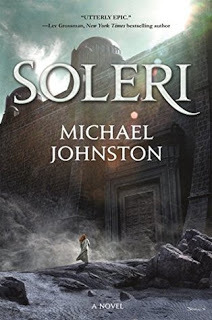
I'm going to do the awful thing that I am loath to do, by comparing this novel, at a glance, to GRRM's ASoIaF, because it follows a similar theme – a family torn asunder by political intrigue and war. And there were certain predictions I made while reading which had touchstones of familiarity in terms of theme.
It's going to be difficult for me to give an overview without spoilers, but I'll do my best. We meet Ren, who is the heir to the Harkan throne. Like all heirs, he's sent to the capital of the empire, to be held as a hostage in the Priory, along with the heirs of the other vassal kingdoms.
We get to know the Harkan king, Arko, who finds himself called to the heart of the empire, where he learns the secret behind the throne of the emperor no one has seen for centuries.
Priestess Sarra, Arko's estranged wife, schemes and plots – she desires power, and she's not afraid of walking all over Arko to get it.
But then we have Kepi and Merit – Arko's daughters. And they couldn't be more different. Merit is the queen regent in Ren's absence, while Kepi is a free spirit, more keen to brawl than take on the responsibility of her bloodline.
This is no loving family – you have been warned.
Overall, the Johnston's writing is fast-paced and filled with action, and I really enjoyed the setting, and the fact that we get glimpses into the history of an ancient city and empire. There were moments where the editing slipped up a bit – a scene where Kepi discards a blade only for it to show up in her hands a few paragraphs later. And at times I did feel that the writing was a smidge on the fast side, where some filling in of characters' motivations would have helped pad things out. But these were not deal-breakers for me.
I have to make mention of the one serious issue that did make me grumble. One of the viewpoint characters has a secret. A pretty big one, too, that they conveniently neglect to think about but then toss in at the end of the story as a big reveal. Firstly, I don't think there was enough foreshadowing, and secondly, I feel that this was a bit of a cheap shot to build suspense – almost as big as a viewpoint character being a murderer and conveniently neglecting to think about what they've done until right at the end. But I'm going on to book two. Even if I'm grumbling a bit about this one thing that was tossed out at the conclusion of book one.
Soleri is part mystery, part military conflict, and court intrigue. The amount of back-stabbing and reversals that occur is quite dizzying at times, and not wholly unexpected given the characters. And the story is set up in such a way that I'm sure every reader will have a particular character that they'll root for. I'm really curious to find out more about who these mysterious gods – the Soleri – really are.
March 29, 2021
Dracul by Dacre Stoker and JD Barker
With the slew of vampires cropping up in fiction over the past while, it's a pleasant change to return to a story that has all the hallmarks of the classic that helped spawn the genre. Even better that it's Bram Stoker's great-grandnephew, Dacre Stoker, who, informed with access to primary source materials, has guided the direction that Dracul has taken.
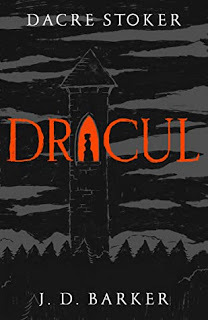
The novel starts with a twenty-one-year-old Bram Stoker who's in a spot of bother in a tower of a ruined abbey, and to a degree it might seem somewhat contrived for someone who's in a tight spot having the wherewithal to scribble down the events that have led up to his current predicament, the story is quite cleverly put together. Much like Dracula, it's made up of letters and journal entries, jumping between past and present to delve deeper into the story that has been a staple of horror for more than a century.
Blending elements of mystery with horror, our protagonists – Bram and his siblings, along with a handful of accomplices – find themselves on an unexpected quest that sees them make some unlikely allies. I can't say any more for fear of spoilers, but I was soon invested in how the story plays out.
In tone and styling, Dracul is very much the epitome of a Gothic novel, bursting at the seams with ruinous abbeys and bloodthirsty monsters. The supernatural elements creep in gradually, and while very little terrifies me these days, I appreciated the twists and loops this story follows before it hurtles towards its conclusion. If you're familiar with the original text of Bram Stoker's Dracula, then Dracul will offer a worthy deeper dive into the legend that is sure to please fans.
March 26, 2021
Dead Acre by Rhett C Bruno and Jaime Castle
Every once in a while I like to mix things up a little and read something that's pulpy and fun. Or, in this case, should I rather say listen to. Dead Acre cropped up in my recommended titles courtesy of my Audible subscription, and because it was a quick read (and included), I gave it a spin.

I see in the blurb that they peg this story as a Witcher-meets-Dresden-Files and while I haven't read the latter, I do admit to being somewhat of a Geralt of Rivia kinda gal. So yep, if you're into a weird west setting chock full of monsters, then James Crowley's dry wit and wry outlook on his unlife as an immortal monster hunter – or Hand of God – may well scratch that itch.
Dead Acre doesn't offer me anything new that I haven't already seen in countless horror RPGs, films, and urban fantasy settings. Hells, it even has a bit of a noir edge to it, which I felt added some good flavour. There's even a sweet little reversal in terms of expectations relating to the Big Bad at the end. I'll admit, I didn't *quite* see that one coming. And while I didn't get my socks knocked off completely, I'll quite happily say that I was entertained, and that's what counts.
A word on Roger Clark, who does the narration for Dead Acre. He has A VOICE on him. That alone makes this title a welcome addition to my collection.
March 21, 2021
The Five Senses Set: Mirror of Destiny, The Scent of Magic, and Wind in the Stone (Five Senses #2-4) by Andre Norton
Andre Norton is one of those authors I've been meaning to dip into again for years, so when the Five Senses Set of three novellas was on sale on Amazon, I decided to give it a try. Certainly, the list of titles to her name is formidable, and from a perspective of giving love to the older works of SFF out there, I felt it was valuable to revisit. But...
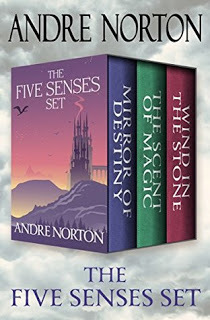
There's going to be a but here.
I need to relook some of her more popular works for comparison, because this collection was so far off the mark for me in terms of the quality of the writing.
Overall, there's a theme in each story – of a young woman who inherits or possesses a rare magical skill related to the senses, who sets out to right an imbalance along strongly expressed lines of good and evil. Norton also brings across inventive world building, but it's not enough for me – across the board I felt there was something off with each story, be it the pacing or the lack of attention to characterisation. Not to mention the clumsy sentence construction. Whether the latter is a product of its time or simply that these stories were never subjected to the tender mercies of both a structural and copy editor's talents, I don't know.
In Mirror of Destiny Twilla inherits a magical mirror from her teacher, but before she can establish herself as more than a trainee wise woman, she is whisked off as a prearranged bride for people in a nearby land. By some luck, she ends up in the duke's household, destined for his son, but the marriage is not to either of their taste, so she makes her escape that leads her to the forest, and the breaking of an ancient curse that binds the fair folk of this world. The biggest issue I had with this story was that the pacing dragged, and I didn't once feel as if the characters were ever in any real danger that they had to overcome.
The Scent of Magic sees Willadene escape a life of drudgery as a scullery maid to apprentice her to a herbwoman – as Willa has the ability to sniff out magic, which is apparently a rare talent indeed. We also see the point of view of the baron's daughter, who upon gaining her majority, starts working on gaining power – so that was at least interesting, seeing a woman working on feminine power in a patriarchal society. There's a larger plot afoot too, once again tied into an ancient evil, and the story heads off into a completely different direction near the end. Of the three novellas, this was the one that I felt was structurally stronger. But it was still a slog.
Wind in the Stone absolutely starts in the wrong place, with its first part essentially just back story that sets up the events that take place in the second half. Other reviewers despised this story (from what I can pick up) due to the fact that there is a scene that involves the rape of a young woman. I just found this story unutterably dull, to be quite honest. Stuff happens, and there's an antagonist who appears to be power hungry for the sake of being power hungry. Oh, and the Sasquatch. Which are an interesting addition to the plot if they served any real purpose other than writing a story that features Sasquatch. I suppose it makes a difference from elves and dwarves, I guess.
Look, I'm sure there are some of Norton's other books that are good. I recall reading one of her Witch World books when I was much, much younger, and finding it a fair read, but none of these three in this collection are what I would call sterling examples of the genre. Stilted dialogue, great need for structural edits, and peculiar diction all combine to make these uncomfortable reads that were a relief to finish and make me doubt whether I am brave or foolish enough to pick up any of Norton's other writing. As a peculiarity of the genre, this was interesting to read, and there were moments when some of the leaps of imagination hinted at greater depths (like the malevolent forest ruins in The Scent of Magic). Mostly, I just felt like there wasn't enough depth in the writing to convince me of the characters' motivations. And yes, all my aforementioned issues.
So read this one at your own peril. Obviously, if you're a huge fan of Norton, and she can do no wrong for you, then kindly disregard this review. I was mostly disappointed with this collection.
March 20, 2021
The Adventures of Tom Finch, Gentleman by Lucy May Lennox
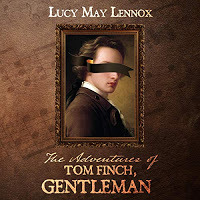
Narrated by Duke DeFoix, Duchess DeFoix, Olivia Featherton, and Earl Tyrone, this audiobook is a delight from start to finish – each character shining against a well-researched, well-written historical narrative.
At its heart, this tale follows the doings of one Tom Finch, a composer, conductor and musician operating out of London in the mid-1700s. Tall, handsome and a shameless flirt, Tom is also blind – yet he navigates the theatres and streets of London in fine style. The natural son of a nobleman, Tom doesn't have many prospects – he can't serve in the navy or the army due to his disability, but he's carved a good life for himself conducting operas and writing broadsides with the assistance of his friend. And in fact, his disability perhaps stands him in good stead, for his ability to listen far surpasses that of the sighted.
Tom may be a libertine, but his heart belongs to the free-spirited, gamine Sal, a sometimes bawd and highway robber. But the singer Tess also creeps into his heart, and their friendship has its ups and downs. In fact, by the time I was done with the story, I felt as if the enormous support cast had become the kind of friends I'd expect to meet on the street – and it's a rare thing indeed for a story to grip me like this.
A word also on Lennox's musical knowledge – this novel is incredibly well researched in terms of giving the technical aspects of late-baroque music a ring of authenticity. And while the plot is a rambling journey, it all nonetheless hangs together in a glorious intermeshing of narratives. Each chapter is episodic and almost self-contained, yet contributes beautifully to the overall development of the story – and let me tell you there are not that many authors I've encountered who can pull this off so well.
I also particularly enjoyed the fluidity of characters' sexuality in a way that felt effortless – many of the characters are bisexual, and no big deal is made of this, which I appreciated. It felt natural and appropriate for the mood of the particular scenes.
I was almost heartbroken by the time I reached the end of this tale and can heartily recommend this well-tuned romp through London, with visits to the English countryside, a troubled crossing of the English Channel and also a flirtation with Paris.
March 1, 2021
Quick ID Guide: Wild Flowers of the Cape Peninsula by Hugh Clarke and Corinne Merry
The Cape Floral Kingdom is considered a hotspot in terms of biodiversity, and many truly special species can be found in the Cape Peninsula. The City of Cape Town is unusual, in that it has a National Park running right through its heart, and for many Capetonians it's as simple as a ten- to fifteen-minute drive to get close to nature. Observant nature-lovers are bound to see any number of floral beauties, no matter the time of year, and in this Quick ID Guide: Wild Flowers of the Cape Peninsula, authors Hugh Clarke and Corinne Merry sketch out an introduction to the most commonly encountered blooms.
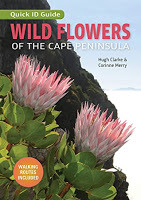
Wild Flowers of the Cape Peninsula not only serves as a guide to the different species, but also provides simple maps that assist with the planning of your hiking trip and offers an introduction to the floral beauties of the region that is useful to those who are new to putting a name to a flower and more seasoned nature-lovers alike.
I've found the way the book is laid out to be quite useful too – flowers are not arranged by the season, as I would have expected, but rather by their colours, with photos that display their defining characteristics. Further information includes the flowering season, height, descriptions, leaves, distribution and habitat. Pointers on how to find particular flowers is also offered, along with helpfully colour-coded walking routes and advice on how to explore safely and sensibly – especially if you are considering an ascent of Table Mountain.
This slim volume will easily slip into your backpack, and it's most certainly a book I'll be referring to the next time I head out into the veld. As a Capetonian who's done a fair bit of hiking, it's been wonderful to be reminded how much beauty exists right on my doorstep.
February 21, 2021
Orca by Richard Peirce
Anyone who's local to the False Bay coastline will no doubt have a passing familiarity with our local shark cage diving industry that's a huge tourist attraction. In Orca, Richard Peirce, takes a deep dive into the shark cage diving community of Gansbaai in particular, and gives us a glimpse into the complex, interlocking of community and nature, and the difficulties a community faces when they rely heavily on a natural resource that is increasingly under environmental pressure.
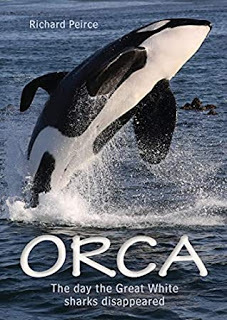
The great white sharks of False Bay are known for their population density and also their habit of breaching, when hunting their prey of Cape fur seals. This understandably has resulted in many exciting photographic opportunities in addition to the chance for visitors to get up close and personal in the cages that are submerged at the spots sharks often frequent.
Sleepy little seaside towns like Gansbaai have, over the years, been transformed into mini tourist meccas, with many local operators launching several shark-viewing trips a day. At least that was until the majestic great white sharks vanished. Even more disquieting were the carcasses of mature sharks washing up on beaches in the region. What could be killing the sharks?
Peirce pieces together the mystery, relating how a pair of roving orcas, named Port and Starboard for how their dorsal fins have flopped over, have developed a somewhat grisly taste for great white sharks – particularly their livers – and how they periodically return to prey on a supposedly apex predator.
Naturally, when the great whites vanish, this has a catastrophic effect on the community, which has consequently adapted to these 'droughts'. Fortunately, there are species of shark that have saved the day, for instance the smaller bronze whaler sharks, and tour operators have looked at diversifying the activities that they offer to make up for the times when the great whites are MIA.
What Peirce highlights is the fragility of our ecosystems, and especially our oceans, which are under so much pressure. Is this new behaviour from the orcas? How have humans had an impact on our environment? While there is no convenient closure to this book, it does serve as a cautionary tale for those of us who live close to the ocean and those who rely on it for a livelihood.
February 16, 2021
Entreat Me by Grace Draven
I can never get quite enough of Grace Draven's writing when I'm in the mood for a gothic romance, which is very much her forte, offering crumbling edifices, doom-laden loves and clever dialogue. Her writing feels as though it harks back to the Brontë sisters, which makes me entirely happy (and yes, I'm a huge Wuthering Heights fangrrrl, so bite me). In Entreat Me, Draven riffs off the old classic Beauty and the Beast, but done in her signature style, which means you'll recognise elements of the template, but the story takes quite a number of surprising twists and turns.
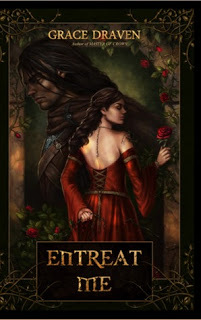
In short, the widow Louvaen is fiercely protective over her younger half-sister Cinnia, and when the latter pulls a runner to abscond with a dashing son of a mysterious warlord in his remote demesne, Louvaen thinks nothing of it to play chaperone while the young lord courts her sister. Except Louvaen has run straight into the snarled thorns of a centuries-old curse, and her presence may well prove the linch pin to end it even as she finds her own love in the most unexpected place.
Firstly, Louvaen is my kind of heroine. She's an older woman, she is brimful with courage and attitude, and she is not afraid to speak her mind ... or act. Which in a man's world can and does make her a powerful enemy (but I won't spoil). Draven has outshone herself with this book, delving deep in to the daily life surrounding a castle, and I absolutely adore the ring of authenticity she imbues in her writing, even to the details of spinning flax (yes, this is something I've actually recently researched).
Entreat Me unravels slowly until it tangles into a cataclysmic end, filled with magic and danger and yes, true love. Her characters' interchanges are an absolute treat too, and she manages to bring across an archaic feel that is lively with humour. (Louvaen really has a sharp tongue that is a wonder to behold.) Yes, this is a kissing (and more) kinda book, but the erotic elements never overshadow the plot, which makes it my kind of romance.
Now excuse me, while I go track down the next book by Grace Draven that I haven't read yet...
February 14, 2021
Fire Within by Morten W Simonsen
Fire Within by Morten W Simonsen is a fantasy novel that at the start, I felt, had a lot going for it. We kick off with a prison break then immerses readers in a world on the brink of war with a non-human race. The story centres around two brothers who, through circumstances, are placed at odds with each other by a father who requires nothing but exact compliance – and it's brother Ivan who's drawn the shortest straw, cast out of his family, outlawed and reviled, who now seeks to tear it all down from the bottom up with his outlaw gang. We have Thedric, who lives in the shadows of his elder brothers, who feels he can never quite measure up, to the detriment of his own selfhood as he tries and fails to impress his father, the Lord Styles.
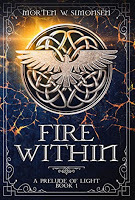
Then we also have Ani, who is in possession of the kind of secret that will see her a valuable pawn in the hands of men who desire power. Out of all the characters, I feel she was the most poorly developed – either the author purposefully drew her out to be hopelessly naïve on purpose, or he doesn't know the first thing about writing a female character in the first place. I know I'm coming out a bit harsh here, but honestly, as a woman who's an avid fantasy reader, this has got to be one of the most frustratingly annoying characters I've encountered in years. Either way, she was the one reason why I wanted to hurl my iPhone across the room out of sheer annoyance. Then, the Thing (I think you can figure out what I mean without me saying it) that happens to her near the end was, in my opinion, so hopelessly unnecessary and as a plot device felt wedged in and something along the lines of 'let's do a terrible thing to a woman for the sake of being grim.' I get that her character is 'special' but the way she is developed as a character in this first book is the reason why I'm downgrading the review to three stars and will in all likelihood not bother reading the rest of the books.
This is clearly the first book of a series, and as such there's a lot of set-up with a bunch of threads left up in the air at its close. Simonsen's writing is adequate, but I do feel this work could have used a bit of spit and polish not only from structural edits, but a bit more of a thorough copy edit overall. I saw quirks that only a copy editor would notice, which jerked me out of the reading (and I do try to separate my reader brain from my editor brain, but in this case I was not as successful, evidently). If you're looking for action-packed, grimdark, then this story will most likely hit the right buttons, but its execution was in my not-so-humble opinion a bit rough around the edges and in need of deeper development.
February 13, 2021
Field Guide to Mushrooms & other Fungi of South Africa by Gary B Goldman & Marieka Gryzenhout
Mushrooms have fascinated me from a young age, and always with my mother's admonishment of certain death should I even think of touching them unless they were prepackaged from the local store. Yet in recent years we've also seen growth in interest for foragers taking advantage of South Africa's great diversity of fungi, many of which are not just edible, but downright delicious, be it a pine ring or Kalahari truffle. In their Field Guide to Mushrooms & other Fungi of South Africa by Gary B Goldman & Marieka Gryzenhout have created a functional and informative guide that, I hope will, not only serve as a clear guide to steer foragers to delicious edible boletes but help them identify the poisonous copper trumpets, salmon coral, aptly named death caps and more.
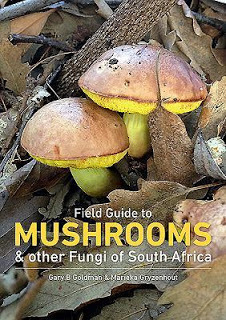
But this book is more than that – in my mind it serves as an enticement to look closer at nature, for there are so many fantastic types of fungi – a whole wonder world of them worth exploring. By the time I was done flipping through these pages, I was on the verge of buying a macro lens for my iPhone. My sense is that we spend so much time exploring South Africa's macro-fauna, we completely overlook these subtle, ephemeral beauties.
As with any field guide, there is only so much information that can be given. The introduction offers the usual of the instructions on how to use the book, what mushrooms are, their growth and reproduction, their identification, the fungal kingdom as a whole, the role of mushrooms in nature, edible and poisonous kinds, foraging, and also photographing mushrooms.
The species accounts offer many clear photos and concise descriptions that most certainly make IDing mushrooms far easier, and not only that, but there's even a bunch of recipes at the back – so I'd hazard to say, this book offers just about everything you need to get started for your mushroom hunting, whether you're framing photos, taking spore prints or collecting for your next meal.



